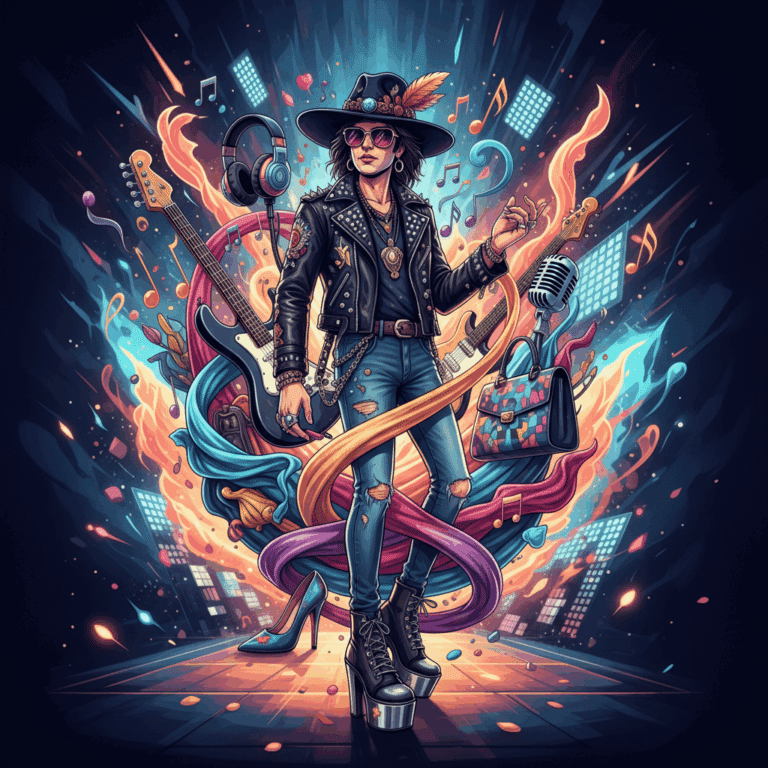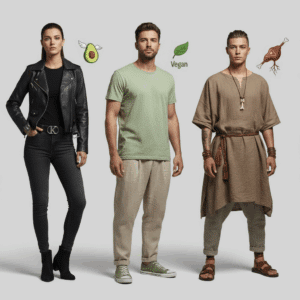Musicians’ Impact on Fashion Through History
The influence of musicians on fashion has been profound throughout history. Their personal styles have often sparked entire fashion movements that extend beyond music culture. This interplay between music and fashion reflects social and cultural shifts over time.
From the rebellious spirit of rock ‘n’ roll to the provocative trends of punk, musicians have consistently challenged conventional dress codes. These iconic styles have inspired generations and continue to shape how fashion evolves globally.
Rock ‘n’ Roll and the Birth of Fashion Statements
Rock ‘n’ roll revolutionized fashion in the 1950s and 1960s, with artists like Elvis Presley leading the charge. His leather jackets, slicked-back hair, and rhinestone jumpsuits became symbols of youthful rebellion and bold masculinity.
These looks introduced a new form of self-expression and showmanship, making fashion a key element of the rock star persona. The Beatles and The Rolling Stones also influenced fashion with their sleek mod suits, blending music and style seamlessly.
Punk and Mod Movements: Rebellion in Style
The mod movement embraced sharp, tailored clothing, as seen in the suits of iconic British bands, influencing a clean-cut but edgy aesthetic. This style embodied a youthful, aspirational identity tied closely to music scenes.
Conversely, the punk movement ushered in a raw, DIY approach to fashion. Bands like The Sex Pistols popularized ripped clothing, safety pins, and unconventional hairstyles that projected defiance and anti-establishment attitudes. This rebellious style remains a powerful fashion statement today.
Iconic Fashion Trends Set by Pop and Hip-Hop Artists
Pop and hip-hop musicians have continuously redefined fashion, introducing trends that resonate worldwide. Their bold styles often merge music, culture, and personal identity, influencing millions.
These artists use fashion not only as self-expression but also as a way to challenge norms and inspire new cultural aesthetics, making their wardrobes essential in shaping modern style landscapes.
1980s Pop Icons and Their Fashion Reinventions
The 1980s saw pop legends like Madonna and Michael Jackson pushing fashion boundaries. Madonna’s provocative looks and use of lingerie-inspired outfits redefined feminine empowerment and style diversity.
Michael Jackson’s signature red leather jackets and sequined gloves became staples of pop culture, blending theatricality with streetwear and influencing fashion designers globally.
Cher’s continual reinvention of styles—from glam to bohemian—showcased the decade’s eclecticism, cementing pop stars as fashion innovators beyond music.
Hip-Hop’s Mainstream Influence on Streetwear
Hip-hop culture emerged as a dominant force in fashion during the late 20th century, popularizing oversized clothing, athletic wear, and flashy accessories like gold chains. These choices echoed the genre’s roots and sense of identity.
Artists such as Run DMC and Tupac helped bring streetwear to mainstream audiences, turning casual urban aesthetics into recognized fashion statements worthy of global emulation.
More recently, hip-hop stars have blurred lines between luxury fashion and streetwear, bringing exclusive brands into everyday wardrobes and redefining high fashion norms.
Modern Collaborations Between Musicians and Luxury Brands
Contemporary musicians actively collaborate with luxury brands, creating collections that merge street culture with high-end fashion. These partnerships often generate viral trends and exclusive, sought-after pieces.
Artists like Kanye West have launched innovative sneaker lines, while Rihanna’s Fenty and Beyoncé’s Ivy Park brands lead inclusivity and creativity in fashion, appealing to diverse audiences worldwide.
These collaborations reinforce musicians’ roles not only as style icons but also as influential entrepreneurs shaping global fashion markets.
Musicians as Sources of Inspiration for Fashion Designers
Musicians have consistently served as muses for fashion designers, inspiring collections that capture the essence of their unique styles. Designers translate the boldness, attitude, and cultural significance of music into tangible fashion statements.
This relationship allows fashion to embrace storytelling, where the energy and identity of an artist become woven into fabrics, patterns, and silhouettes. As musicians evolve, designers adapt their vision, creating innovative and dynamic collections.
Translating Music Style into Designer Collections
Fashion designers often study a musician’s persona and stage presence to craft collections reflecting their distinctive style. This process involves capturing the mood and cultural context that the music conveys.
For example, punk’s rebellious spirit inspired designers to incorporate distressed fabrics and hardware elements, echoing the genre’s anti-establishment ethos. Similarly, the glam rock aesthetic brings glitter, metallics, and theatrical details into runway shows.
By interpreting musicians’ fashion, designers create garments that resonate with fans and trendsetters alike, bridging the gap between performance and everyday wear. This synergy highlights music as a wellspring of creativity in fashion innovation.
Fashion as Cultural Expression Through Musicians
Musicians have long used fashion as a powerful tool to express cultural identities and social values. Their styles often embody the spirit of movements and resonate deeply with audiences worldwide.
Through their sartorial choices, artists reflect and influence subcultures, creating visual languages that signify group belonging and personal freedom. This interplay defines fashion as a dynamic cultural expression.
Subcultures and Sartorial Codes Influenced by Artists
Artists often pioneer distinctive styles that evolve into recognized subcultural dress codes. For example, punk’s torn clothing and safety pins, pioneered by bands like The Sex Pistols, symbolized rebellion and anti-establishment views.
These sartorial codes go beyond mere aesthetics; they communicate ideological stances and foster a sense of community among followers. Fashion becomes a uniform for shared values and identity.
Similarly, grunge fashion reflected by Kurt Cobain’s flannel shirts represented disaffected youth culture. Musicians’ looks thus serve as templates for entire social groups seeking distinct expression.
Musicians’ Role in Shaping Social Identities Through Fashion
Musicians shape social identities by challenging norms and encouraging self-expression through fashion. Their styles inspire fans to adopt looks that reflect diverse backgrounds and personalities, reinforcing individuality.
Fashion influenced by artists often becomes shorthand for cultural attitudes, signaling inclusion or resistance. Icons like Bob Marley popularizing military jackets linked fashion with political and cultural identity.
This ongoing dialogue between music, fashion, and identity highlights musicians as architects of social symbolism, continually evolving sartorial narratives aligned with cultural change.






